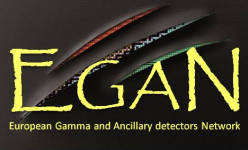Speaker
Calin Alexandru Ur
(INFN PD)
Description
The GALILEO project has the goal to build of a 4pi high-resolution gamma-ray array by combining the GASP tapered detectors with the Gammapool Cluster detectors. The array will be located at the National Laboratories of Legnaro and will take advantage of the stable beams provided by the Tandem-ALPI-PIAVE accelerator complex and, in the future, of the exotic radioactive ion beams provided by SPES. One of the objectives of the project is to rearrange the original EUROBALL 7-capsules clusters into triple clusters. The triple cluster detectors will be placed at 90 degrees while the GASP tapered detectors will cover the forward and backward angles symmetrically. Several R&D activities are ongoing to develop a complete cryostat for the new triple cluster detector and to build the corresponding anti-Compton shields. The development of the front-end, digital sampling, pre-processing and readout electronics take advandage of the recent achievements of the AGATA project in these fields.
A strong physics case was made for the building of the GALILEO array based on Letters of Intent submitted by several research groups from all over the world. The research topics expressed in the Letters of Intent cover a wide range of challenging nuclear structure physics issues to be investigated by means of gamma-ray and particle spectroscopy. They cover the study of nuclei from one edge of stability at the N=Z line to the other edge in neutron-rich regions. Experiments include full spectroscopy of the nuclei of interest, lifetime measurements via Doppler shift or fast timing techniques, g-factor, quadrupole moments and transition probabilities measurements in Coulomb excitation and multi-nucleon transfer reactions.
Many of the proposed experiments are challenging and require the coupling of the gamma-array to state-of-the-art ancillary detectors, such as the EUCLIDES light charged particle detector, the DANTE MCP array, the RFD recoil detector, the Cologne plunger, the TRACE E-DE Si pixel detector, neutron detectors (n-Ring, N-Wall, NEDA), the LUSIA array of DSSSD detectors, arrays of MW-PPAC. The holding structure of the GALILEO array is designed in such a way to allow an easy coupling to a wide range of ancillary detectors.
In the present talk the status and perspectives of the GALILEO project will be discussed.
Primary author
Calin Alexandru Ur
(INFN PD)

